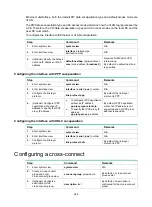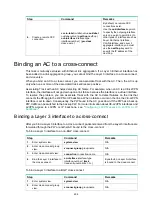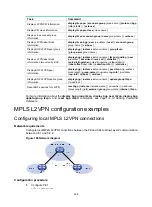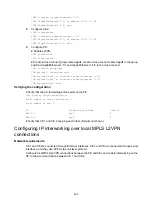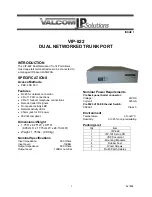
395
establish Layer 2 connections with the PEs. For example, CE 2 and PE 2 must perform PPP
negotiation to establish a PPP connection.
PW redundancy
PW redundancy provides redundant links between PEs so that the customer networks can
communicate when the path over one PW fails. As shown in
, PE 1 establishes two PWs
(one primary and one backup). The CEs communicate through the primary PW. When the primary
PW fails, PE 1 brings up the backup PW and forwards packets from CE 1 to CE 2 through the backup
PW. When CE 2 receives the packets, it updates its MAC address table, so that packets from CE 2 to
CE 1 also travel through the backup PW. Only static PWs and LDP PWs support PW redundancy.
Figure 104 PW redundancy
The MPLS L2VPN determines whether the primary PW fails according to the LDP session status or
the BFD result. The backup PW is used when one of the following conditions exists:
•
The public tunnel of the primary PW is deleted, or BFD detects that the public tunnel has failed.
•
The primary PW is deleted because the LDP session between PEs goes down, or BFD detects
that the primary PW has failed.
•
A manual PW switchover is performed.
Multi-segment PW
A multi-segment PW includes multiple concatenated static or LDP PWs. Creating two PWs for a
cross-connect on a PE can concatenate the two PWs. Upon receiving a packet from one PW, the PE
removes the tunnel ID and PW label of the packet, adds the PW label of the other PW, and forwards
the packet over the public tunnel. Only static and LDP PWs can form a multi-segment PW.
, to create a multi-segment PW between PE 1 and PE 4, you can
concatenate PW 1 and PW 2 on PE 2, and PW 2 and PW 3 on PE 3.



















